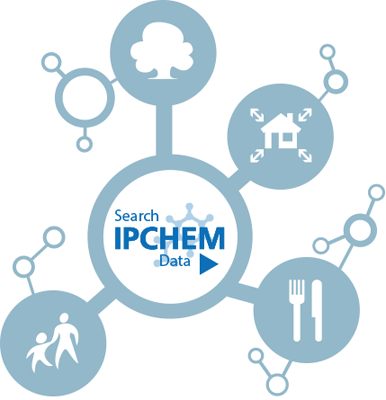IPCHEM - the Information Platform for Chemical Monitoring is the European Commission’s reference access point for searching, accessing and retrieving chemical occurrence data collected and managed in Europe. The platform has been developed to fill the knowledge gap on chemical exposure and its burden on health and the environment. (Read more)
IPCHEM is structured into four modules, according to the chemical monitoring data categorisation: Environmental monitoring, Human Bio-Monitoring, Food and Feed, Products and Indoor Air.
Discover the stakeholders that are making their data available through IPCHEM
EU Research Projects Space
Learn more about the ongoing collaborations with research projects
If you are involved in collecting and handling chemical monitoring data across Europe then you may wish to become an IPCHEM partner
Participation Form
Fill in this form to become IPCHEM data provider and partner
About IPCHEM

Project Information
This is: IPCHEM Version 5.0 (09.03.2018)
IPCHEM - the Information Platform for Chemical Monitoring is the reference access point for discovering chemical monitoring data collections which are managed by and are available to European Commission bodies, Member States, international and national organisations and research communities.
The Platform aims to support a more coordinated approach for collecting, storing, accessing and assessing data related to the occurrence of chemicals and chemical mixtures, in relation to humans and the environment. "This would help identify links between exposure and epidemiological data in order to explore potential biological effects and lead to improved health outcomes" [EC Communication "The combination effects of chemicals – Chemical mixtures" (COM/2012/0252 final)].
IPCHEM is designed and implemented as a de-centralised system, providing remote access to existing information systems and data providers.
Objectives
IPCHEM primary objective is focused on:
- Assisting policy makers and scientists to discover and access chemical monitoring data on existing, new, emerging and less-investigated chemicals covering a range of matrices and media;
- Hosting data currently not readily accessible (e.g. outcomes of research projects, off-line stored monitoring data, etc.)that will be searchable and accessible through the platform;
- Providing chemical monitoring data and information of defined quality in terms of spatial, temporal, methodological and metrological traceability.
On the medium/long term IPCHEM will focus on data quality and usability as well as on facilitating exposure and risk assessment practices in support of EU policies.
Benefits
IPCHEM platform envisages of providing the following benefits for its end-users:
- Facilitating a fast retrieval and accessibility to chemical monitoring data stemming from different sources through one unique reference gateway;
- Improving quality and comparability of chemical monitoring data used in chemical exposure and risk assessment processes;
- Enabling the evaluation of the effectiveness of chemical policies/legislation to reduce chemical exposures and their effects to human health and the environment on the basis of best available quality data;
- Supporting a better planning of future chemical monitoring campaigns at EU and Member States levels and a resource efficient sharing of data and analytical methodologies.
IPCHEM Data Providers
IPCHEM data providers are primarily those entities dealing with chemical monitoring data , who wish to make smart use of the opportunities arising from Data Sharing Policies as laid down in the INSPIRE Directive. The data include concentrations of chemicals (occurrence data) in various media measured in the context of surveillance and monitoring activities, for checking compliance against regulatory limits, assessing intervention measures and/or other types of investigations.
 European Commission
European Commission
|
AIRMEX - European Indoor Air Monitoring and Exposure Assessment Project
Metadata info (DG JRC  ) )
|
Contact Point: Otmar Geiss |
|
BIOSOIL - Biosoil Data
Metadata info (DG JRC  ) )
|
Contact Point: Marc Van Liedekerke |
|
FATE - JRC FATE Monitoring Database on Occurrence and Levels of Chemical Contaminants
Metadata info (DG JRC  ) )
|
Contact Point: Bernd Gawlik |
|
LUCAS - Land Use/Cover Area frame statistical Survey
Metadata info (DG JRC  ) )
|
Contact Point: Marc Van Liedekerke |
|
SINPHONIE - Schools Indoor Pollution and Health Observatory Network in Europe database on chemical and biological pollutants
Metadata info (DG SANTE  ) )
|
Contact Point: Agnes Marta Molnar |
|
WATCHLIST - First pilot study for watch list mechanism
Metadata info (DG JRC  ) )
|
Contact Point: Bernd Gawlik |
| WFD - Database of revised priority substances under the Water Framework Directive Metadata info (DG ENV  ) ) |
Contact Point: Helen Clayton |
European Agencies
 European Environmental Agency (EEA)
European Environmental Agency (EEA)
|
AIRBASE - European air quality database
Metadata info |
Contact Point: David Simoens |
|
WATERBASE-LAKES - Waterbase - Lakes (hazardous substances)
Metadata info |
Contact Point: Fernanda Néry |
|
WATERBASE-RIVERS - Waterbase - Rivers
Metadata info |
Contact Point: Fernanda Néry |
|
WATERBASE-TCM - Waterbase - Transitional, Coastal, Marine (hazardous substances)
Metadata info |
Contact Point: Fernanda Néry |
 European Food Safety Authority (EFSA)
European Food Safety Authority (EFSA)
|
EFSA-3-MCPD-esters - Occurrence of 3-monochloropropane-1,2-diol (3-MCPD) in food in Europe
Metadata info |
Contact Point: data.collection@efsa.europa.eu |
Member States Bodies
 German Environment Agency (UBA), Germany
German Environment Agency (UBA), Germany
|
DioxinDB - POP-Dioxin-Database
Metadata info |
Contact Point: Gerlinde Knetsch |
|
ESB-UBA - Environmental Specimen Bank of Germany
Metadata info |
Contact Point: Maria Ruether |
 Flemish Centre of Expertise on Environment and Health
Flemish Centre of Expertise on Environment and Health
|
FLEHS - Flemish Environment and Health Study
Metadata info |
Contact Point: info@milieu-en-gezondheid.be |
 Istituto Superiore di Sanita', Italy
Istituto Superiore di Sanita', Italy
|
PROBE - Programme for Biomonitoring the Italian population exposure
Metadata info |
Contact Point: Alessandro Alimonti |
 I.S.P.R.A. (Istituto Superiore per la Protezione e la Ricerca Ambientale), Italy
I.S.P.R.A. (Istituto Superiore per la Protezione e la Ricerca Ambientale), Italy
|
ISPRA-Pesticides-aggregated - Italian inland water pesticide monitoring - average yearly data
Metadata info |
Contact Point: Pietro Paris |
|
ISPRA-Pesticides - Italian inland water pesticide monitoring
Metadata info |
Contact Point: Pietro Paris |
Research Centres
 EDMaRC - International Center for Research and Research Training in Endocrine Disruption of Male Reproduction and Child Health, Dept. of Growth and Reproduction, Rigshospitalet, Denmark
EDMaRC - International Center for Research and Research Training in Endocrine Disruption of Male Reproduction and Child Health, Dept. of Growth and Reproduction, Rigshospitalet, Denmark
|
Danish-HBM - Danish data on human urinary excretion of non-persistent environmental chemicals 2006-2012
Metadata info |
Contact Point: Hanne Frederiksen |
 National Research Council (CNR), Water Research Institute (IRSA), Italy
National Research Council (CNR), Water Research Institute (IRSA), Italy
|
CNR-PFAS - IRSA-CNR: Perfluoroalkyl acids in Italy
Metadata info |
Contact Point: Stefano Polesello |
Research Consortia/Network
 EMODnet Chemistry consortium
EMODnet Chemistry consortium
|
EMODnet-Chem - EMODnet Chemistry marine dataset of contaminants
Metadata info |
Contact Point: Alessandra Giorgetti |
 DEMOCOPHES partners
DEMOCOPHES partners
|
DEMOCOPHES - DEMOnstration of a study to COordinate and Perform Human biomonitoring on a European Scale
Metadata info |
Contact Point: Greet Schoeters |
 OFFICAIR Consortium
OFFICAIR Consortium
|
OFFICAIR - Indoor air pollution in modern office buildings
Metadata info |
Contact Point: Stylianos Kephalopoulos |
 NORMAN Association (DSE-08-71792-14068A)
NORMAN Association (DSE-08-71792-14068A)
|
EMPODAT - NORMAN database of geo-reference occurrence data on emerging substances
Metadata info |
Contact Point: Valeria Dulio |
International Organisations
 OECD HBM data (outside EU)
OECD HBM data (outside EU)
 CHMS - Canadian Health Measures Survey
CHMS - Canadian Health Measures Survey
Metadata info |
Contact Point: Tyler Pollock |
Projects and Collaborations space
Learn more about the ongoing collaborations with research projects, relevant European and global initiatives, international collaborations and enter into their IPCHEM space
Agreements with EU projects and networks for data provision to IPCHEM
H2020 and FP7 projects providing data to IPCHEM after their completion:
-
EDC-MixRisk (Effects of mixtures of endocrine disruptive chemicals on children)
https://edcmixrisk.ki.se/
-
EuroMix (A tiered strategy for risk assessment of mixtures of multiple chemicals)
https://www.euromixproject.eu/
-
HEALS (Health and Environment-wide Associations based on Large population Surveys)
http://www.heals-eu.eu
-
SOLUTIONS (Solutions for present and future emerging pollutants in land and water resources management)
https://www.solutions-project.eu/
-
DENAMIC (Developmental neurotoxicity assessment of mixtures in children)
https://www.denamic-project.eu/
-
Human Biomonitoring for Europe (HBM4EU) Joint Action
https://www.hbm4eu.eu/
Collaborations
The Human Biomonitoring for Europe (HBM4EU) Joint Action and the collaboration with IPCHEM
HBM4EU Initiative and the collaboration with IPCHEM
 HBM4EU is a joint effort of 26 countries, the European Environment Agency and the European Commission, co-funded under Horizon 2020.
HBM4EU is a joint effort of 26 countries, the European Environment Agency and the European Commission, co-funded under Horizon 2020.
The main aim of the initiative is to coordinate and advance human biomonitoring in Europe. HBM4EU will provide better evidence of the actual exposure of citizens to chemicals and the possible health effects to support policy making.
Data used and produced under HBM4EU will be made accessible via IPCHEM.
The IPCHEM and HBM4EU Data management teams are working in close collaboration to integrate in IPCHEM existing data, enhance the metadata information of the human biomonitoring Module, and improve interfaces and functionalities of our platform.
The JRC is also offering the HBM4EU data repository to allow the Consortium member to upload ad share the data and streamline the integration of the data into IPCHEM.
- Discover more about the project visiting their website
- Access to HBM4EU data repository (only for authorised HBM4EU members)
(only for authorised HBM4EU members)
- Access to HBM4EU metadata overview page
EuroMix (A tiered strategy for risk assessment of mixtures of multiple chemicals) and the collaboration with IPCHEM
 The EuroMix project develops methods for the risk assessment of mixtures of multiple chemicals. Every day, we are exposed to a mixture of multiple chemicals via food intake, inhalation and dermal contact. The number of different combinations of chemicals in mixtures is very large. EuroMix develops a mixture test strategy and test instruments using novel techniques as proposed by the Joint Research Centre (JRC) of the European Commission. The tests will result in data needed for refining future risk assessment of mixtures relevant to national food safety authorities, public health institutes, the European Food Safety Authority (EFSA), the European Chemical Agency (ECHA), industry, regulatory bodies and other stakeholders.
The EuroMix project develops methods for the risk assessment of mixtures of multiple chemicals. Every day, we are exposed to a mixture of multiple chemicals via food intake, inhalation and dermal contact. The number of different combinations of chemicals in mixtures is very large. EuroMix develops a mixture test strategy and test instruments using novel techniques as proposed by the Joint Research Centre (JRC) of the European Commission. The tests will result in data needed for refining future risk assessment of mixtures relevant to national food safety authorities, public health institutes, the European Food Safety Authority (EFSA), the European Chemical Agency (ECHA), industry, regulatory bodies and other stakeholders.
EuroMix is developing a web-based toolbox for mixture risk assessment, as a further development of the current Monte Carlo Risk Assessment (MCRA) platform. The EuroMix toolbox is planned to be delivered in December 2018. The EuroMix toolbox will be a modular web-based platform that enables users to 1) perform the various modelling tasks related to human health chemical risk assessment, 2) organize and share data related to these tasks, and 3) perform these actions in a personal environment. Furthermore, the platform will 4) act as a provider and client of services and data within a network of other platforms and services related to human health chemical risk assessment. EuroMix is collaborating with IPCHEM to enable data exchange regarding human biomonitoring data and potentially other occurrence data.
- Euromix project https://www.euromixproject.eu/
- Prototype EuroMix platform: https://mcra.rivm.nl
The "Pharmaceuticals in the environment - occurrence, effects and options for action" soon searchable and accessible
 UBA, the Federal Environment Agency of Germany recently agrees to make accessible via IPCHEM their "Pharmaceuticals in the environment - occurrence, effects and options for action" database. The project provides data on Measured Environmental Concentrations (MEC) of human and veterinary pharmaceuticals from all five UN regions.
UBA, the Federal Environment Agency of Germany recently agrees to make accessible via IPCHEM their "Pharmaceuticals in the environment - occurrence, effects and options for action" database. The project provides data on Measured Environmental Concentrations (MEC) of human and veterinary pharmaceuticals from all five UN regions.
The data will be searchable via the IPCHEM search tool, thus comparable with the other data collection integrated into IPCHEM.
- Visit the Database's page and learn more about it
and learn more about it
What type of data can be part of IPCHEM?
IPCHEM users can search for and access chemical monitoring data in various media across Europe. Some examples of relevant data collections are: data collected as result of legal obligations on ad-hoc or regular basis for reporting monitoring data at European or national levels; data generated as result of targeted research on the presence of known or unknown chemical substances in specific media in a European country/region.
1 The four thematic modules of IPCHEM
The data collections in IPCHEM are grouped under four thematic modules, representing the main media where chemicals can be found. These modules are:
- Human Biomonitoring data
- Environmental monitoring data
- Food and Feed monitoring data
- Product and indoor air monitoring data




2 IPCHEM approach to data integration
IPCHEM is not a centralised database platform but a distributed infrastructure. This means that the data owners/data providers remain responsible for their own data.
In order to avoid data duplication, we preferred to establish remote connections with remote servers and web-applications. However, we recognise that this is not currently possible for all datasets and we therefore ask the data owners or data providers themselves to identify the best way to make their data available and accessible via IPCHEM.
The "Technical Survey" gathers the preliminary information needed to integrate a data collection into IPCHEM and identifies the best solution for accessing or hosting the data in IPCHEM.
3 Data formats accepted by IPCHEM
Any type of data format is accepted, including:
- On-Line Databases (Relational, NoSQL, ObjectDB, XML DB, etc.);
- Off-Line files (MS Excel, MS Access, CSV files, etc.); and
- Web Services.
4 Data content
For the time being, we cannot provide data templates. We also ask data providers/owners not to make changes to the structure of their data.
The long-term goal of IPCHEM is to promote data quality and data comparability. For this reason IPCHEM has an "internal data model", which captures the core set of information that is harmonised across all data collections of IPCHEM.
The process of transforming, normalising and mapping data from external sources against the IPCHEM internal data model is fully handled by the IPCHEM team. This is made "on the fly" and the original attributes (i.e. the elements that facilitate the understanding and interpretation of the data stemming from external sources) are not replaced or modified. In this way we can ensure a certain level of data quality and comparability across all IPCHEM data collections.
In the "IPCHEM Data Content" file we started to list the attributes recommended for data collections to be integrated into IPCHEM. We will ask you to check whether your data collection(s) has these attributes with the aim of facilitating the harmonisation process.
Who will be able to access your data and at what level of granularity?
IPCHEM is founded on the Open Data principle and our approach to data accessibility is described in detail in the IPCHEM Data Policy. Chemical monitoring data accessible through IPCHEM shall be made available to users at the highest possible level of detail, under the conditions of free, full, open and timely access.
At the same time we fully recognise that data owners/ data providers may wish to restrict access to their data in specific cases, for example, to comply with legal requirements. The cases and conditions for which access to data that are made available via IPCHEM can be restricted are described in the IPCHEM Data Policy.
According to these conditions, data owners/ data providers can decide on the level of detail to which the different IPCHEM User groups can access their data.
1 IPCHEM User groups
To better manage the access to and use of the chemical monitoring data retrievable through the IPCHEM platform, IPCHEM Users are divided into three User Groups that can be granted different levels of data accessibility following the rules set out in the IPCHEM Data Policy:
- European Commission Services and EU Agencies: all European Commission Services and all European executive and decentralised Agencies.
- EU National Bodies: EU Member States Competent Authorities, including Competent Authorities in countries from the European Free Trade Area and EU Candidate Countries.
- General Public: a generic user who does not belong to any of the above-mentioned groups and accesses IPCHEM without authentication, including industry, scientific communities, international and non-governmental organisations.
Data owners and data providers can define the accessibility levels of their own data for each IPCHEM User group, according to the general rules and or restrictions set out in the IPCHEM Data Policy.
Data owners and data providers are always able to access their own data
2 Levels of detail of the data collections integrated into IPCHEM
The levels of detail for the data that can be part of IPCHEM include:
- Metadata
- Aggregated data
- Filtered or generalised single measurement data
- Single measurement data
As a condition of participation in the IPCHEM project, we ask that all data owners and data providers make the metadata of their data collections available to all users. European Commission and Agencies shall always be granted access to the highest possible level of detail (at minimum they shall have access to aggregated data).
3 Definition of terms
Metadata
Metadata means the "general information about the data collection". Metadata is a series of structured information, common to all single measurement data belonging to a specific data collection, which facilitates understanding the background of the data collection and retrieving and working with its associated data.
More specifically, metadata denotes a set of descriptive elements providing specific information on the data collection (i.e. title of the data collection, abstract describing this data collection, etc.). For aggregated data, the metadata includes also information about the statistical method used for the data aggregation. For filtered or generalised data, the metadata also includes information about the type of the data filtering or the generalisation method that was applied.
The IPCHEM website includes a metadata page for each data collection. The aim is to allow IPCHEM Users for:
- Discovering a chemical monitoring initiative for a specific substance and/or media;
- Getting information on the conditions of data use related to a specific data collection;
- Accessing documentation on the sampling and analytical methods used in the specific monitoring initiative;
- Linking to existing technical and scientific documentation related to the data collection;
- Viewing the proof of accreditation of ownership of the data collection.
The information provided by the metadata page for each data collection IPCHEM aims at facilitating users to make an informed use and/or re-use of the data pertaining to a specific data collection by getting familiar with the objective(s) behind and analytical approaches employed in the specific data collection.
Example of metadata
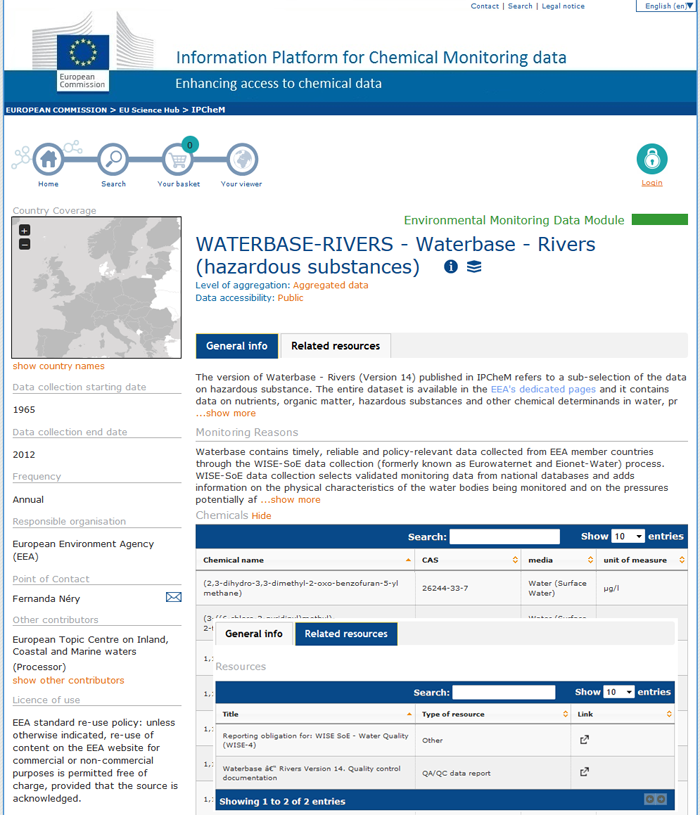
In the search page, clicking on "Metadata info" below the title of the data collection, one can get access to the general information and related resources of the data collection: scientific publications, technical reports, references to sampling or analytical methods.
'Aggregated' data
Aggregated data results from the combination of several single measurements. Individual measurements are replaced with summary statistics based on those measurements. Aggregation can be based on various types of attributes, e.g. spatial or temporal. Summary statistics is recorded into a structured format, is expressed as numeric value and coupled with all attributes needed to contextualise and interpret the data values and to document their quality and reliability.
Example no. 1 of 'Aggregated' data
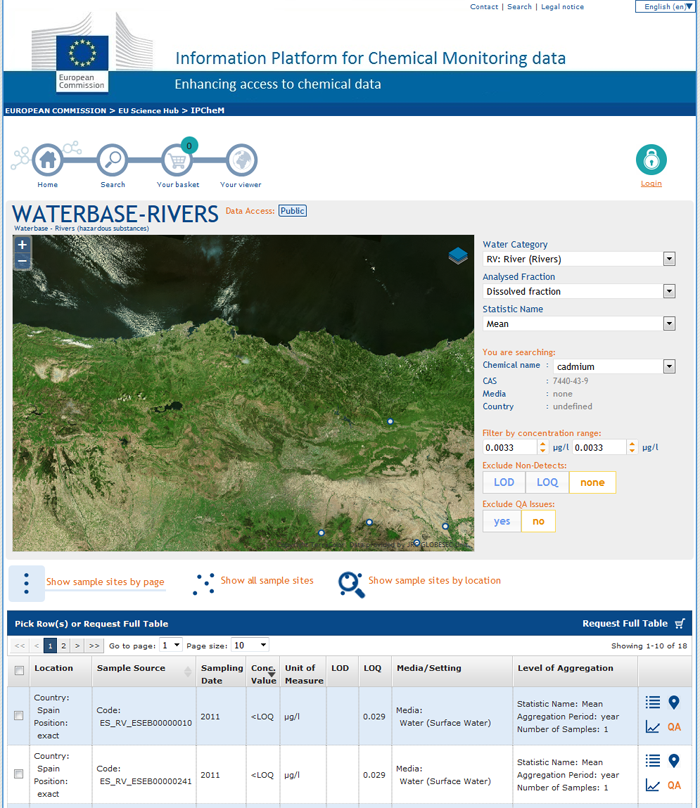
There are different types of data aggregation. In this example Aggregated data means measurements collected in a single sample source or site and is available in the form of statistical data for a certain period of time. This information is reported into the so-called IPCHEM Master Table, under the column "Level of Aggregation", where are usually reported the:
- Statistic name
- Aggregation period
- Number of samples
- Samples below LOQ
In this case the location of the measurements is known and the geographical coordinates are precise. This information is specified under the column "Location" where is reported the value: "exact".
Example no. 2 of 'Aggregated' data
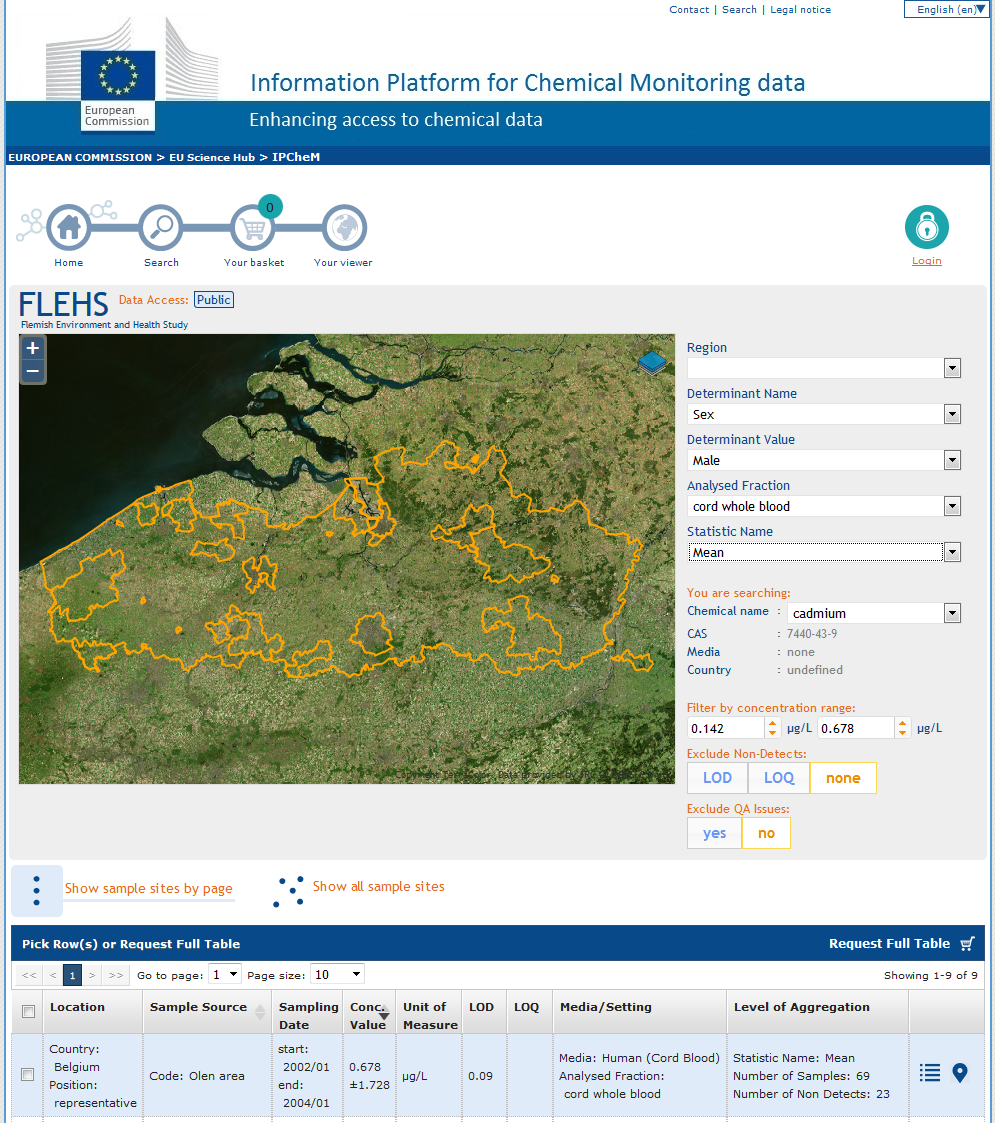
In this second example there is also a spatial aggregation in which measurements were aggregated for a certain period of time and for more sample sources.
Also in this case the information is reported into the so-called IPCHEM Master Table, under the column "Level of Aggregation", where are reported the:
- Statistic name
- Number of Samples
- Number of non-detected
In this case the location of the measurements has been generalised and reported as polygons. This information is specified under the column "Location" where is reported the value: "representative".
'Filtered' or 'generalised single measurement' data
Filtered or generalised single measurement data are single measurement data where specific parameters, such as personal identity and/or the sample source location (i.e. latitude and longitude), have been removed or replaced by generic values.
More precisely, Filtered single measurement data mean single measurement data where certain values or attributes (e.g. personal identity and/or the sample source location) are removed or not made accessible.
Generalised single measurement data single measurement data where a process of generalisation (e.g. spatial) has been applied to some attributes (e.g. reducing the precision of the coordinates of the sample source location).
Example no. 1 of 'generalised single measurement' data
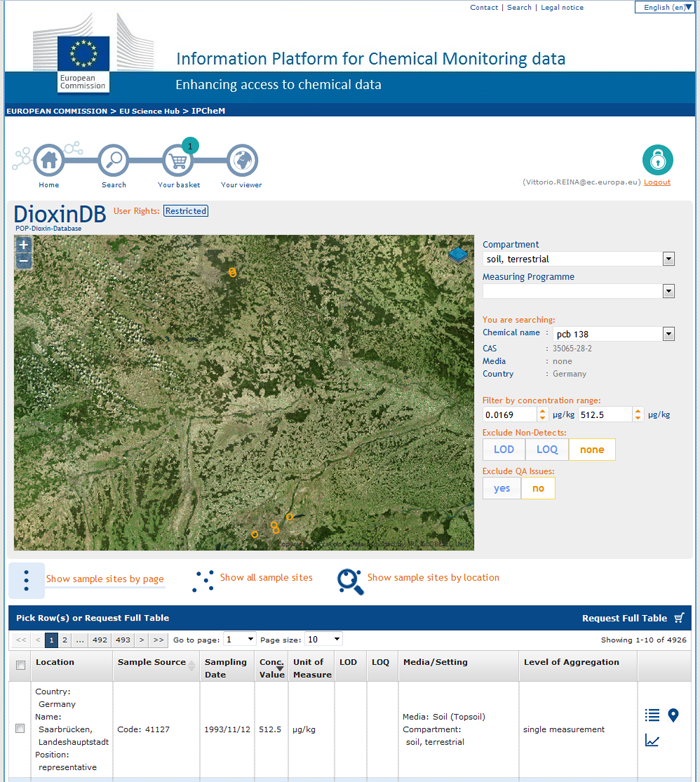
In this first example single concentration measurements are available for each of the sample sources and are reported in the IPCHEM Master Table. However the geographical coordinates of these measurements have been generalised by the data providers (in this specific example by removing decimals). This information is specified under the column "Location" where is reported the value: "representative".
Example no. 2 of 'generalised single measurement' data
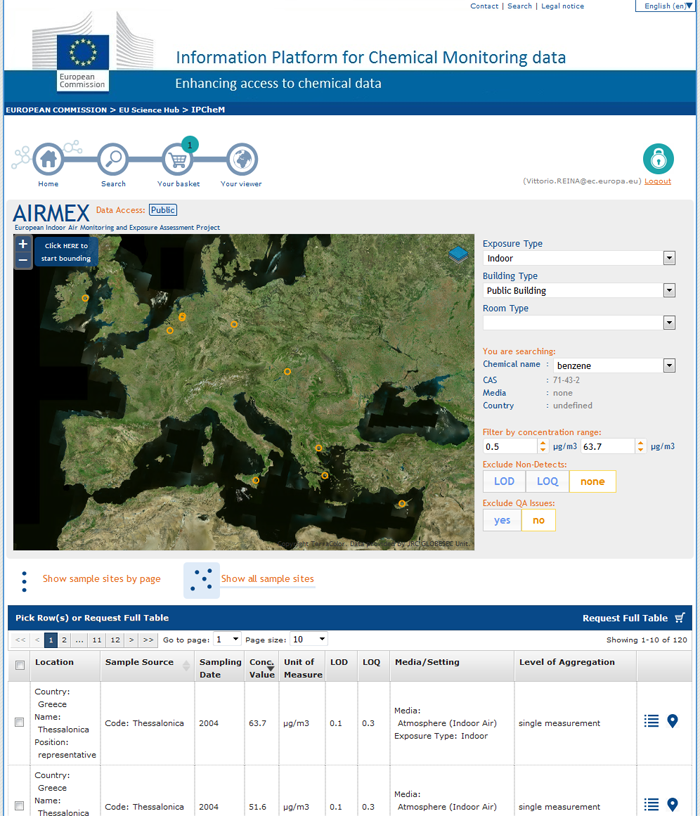
In this second example single concentration measurements are available for each of the sample sources and are reported in the IPCHEM Master Table. However the location have been generalised by the data providers. In this example are reported the name of the cities and, in the map, their centroids. This information is specified under the column "Location" where is reported the value: "representative".
The process of filtering or generalising single measurement data is usually applied to guarantee the protection of privacy (e.g. in case of samples of Human Biomonitoring data) or to ensure that a specific data restriction is respected as specified in the data policy of the original data collection. The process of filtering or generalising data remains responsibility of the data owner or the data provider. The IPCHEM team can provide technical support to the data owner or data provider, if needed.
Single Measurement data
'Single measurement' data represents a collection of individual concentration measurements of a chemical collected in a specific sampling source at defined time points, which after have been analysed is recorded into a structured format as numeric values. This type of data represents the highest possible level of detail which can be accessed via IPCHEM.
Example of 'single measurement' data
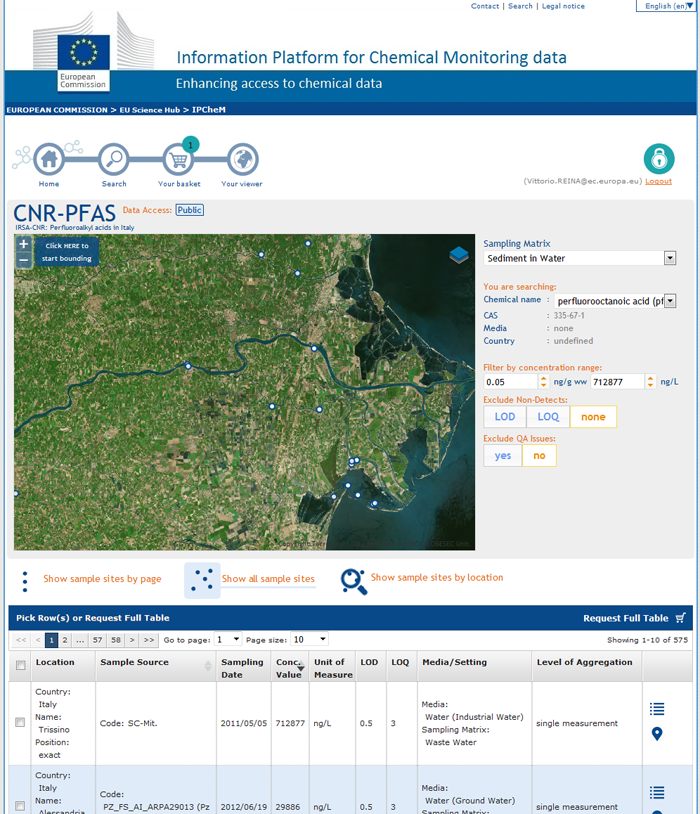
In this example single concentration measurements are available for each of the sample sources and reported in the IPCHEM Master Table. In this case the location of the measurements is known and the geographical coordinates are precise. This information is specified under the column "Location" where is reported the value: "exact".
4 Possible contributors to IPCHEM
Any owner or provider of chemical monitoring data collections can potentially be part of IPCHEM. Contributors may include:
- EU Member States Competent Authorities
- Universities and Research Institutions
- International non-governmental organisations
- Any public and private institution collecting chemical monitoring data
- European Commission Services,
- European Executive and Decentralised Agencies
Data hosting facilities under IPCHEM
We make available for free hosting facilities to data owners and providers who do not have the resources to publish their data online. Data will be hosted by the Joint Research Centre (JRC), the European Commission’s in-house science and knowledge service.
Data hosted at the JRC may have their own data access restrictions and licence conditions, but these must be compatible with the Open Data Principles of the IPCHEM Data Policy and must first be accepted by the European Commission.
Each data owner or provider has the responsibility to inform the IPCHEM team about such licensing conditions using the "Participation Form" (Annex I of the IPCHEM Data Policy) and is also solely responsible to clearly identify data considered commercially sensitive or covered by intellectual property rights that may not be disclosed. All these relevant information must be communicated to the IPCHEM team.
If you are a Data Provider or Data Owner and you wish to make your data collection(s) available through IPCHEM, you can contact the IPCHEM team at: jrc-ipchem-support@ec.europa.eu to get specific info and agree on how to proceed.
Tutorials, presentations and video clips
To discover all IPCHEM tools and functionalities and learn how to use the platform, you can download the IPCHEM quick reference guide for end-users, look at a number of presentations and watch some related video clips.
|
|
|
||||||||||||
|
|
|
||||||||||||
Case Studies on policy questions
A few case studies were prepared to demonstrate the usefulness of the IPCHEM platform and to provide guidance for its competent use which can also be downloaded. These cases studies represent typical situations that are often encountered in real-life practices in policy making processes and help showing how these situations can be supported by IPCHEM.
|
|
|
||||||||||||
How to become part of IPCHEM
If you are involved in collecting and handling chemical monitoring data across Europe then you may wish to become an IPCHEM partner!
IPCHEM will enable you to:
- Share your data with other European organisations and stakeholders;
- Promote your chemical monitoring related activities; and
- Make your data available for policymaking purposes.
This page explains how you can become an IPCHEM partner, what kind of data can be shared and made available and describes options for data access.
For any additional information or clarification, you are welcome to email us to: jrc-ipchem-support@ec.europa.eu
1 Becoming an IPCHEM partner - step by step
The procedure for becoming IPCHEM partner involved five steps.First, the "IPCHEM participation form" (Annex 1 of the IPCHEM Data Policy) should be filled in. In this form you are requested to indicate the level of aggregation of your data collection, as well as your preferred data accessibility regime for different IPCHEM user groups (further described in section 4 below). You are also asked to read and accept the IPCHEM Data Policy. Once completed, please email the form to jrc-ipchem-support@ec.europa.eu or to the Coordinator of the IPCHEM Module relevant to your data.
Second, please provide a standard set of metadata describing your data collection, along with some additional technical information. This will help the IPCHEM team to understand how best integrating your data into the IPCHEM platform. The IPCHEM team is available to support you in accomplishing this task.
Third, your data collection will be integrated into IPCHEM, this being a task of direct responsibility of the IPCHEM team. You will be asked to provide a technical contact point on your side, to facilitate direct communications on technical issues that may arise and need clarification.
Fourth, you will be asked to check your data collection in IPCHEM to make sure that it is presented according to your requirements and meeting your expectations. Before to proceed with making you dataset available on-line via IPCHEM, a preview of your data collection will be made accessible only to you. If needed, you can then request potential changes and improvements to the pages created in IPCHEM presenting your data collection.
According to your feedback, the IPCHEM team will then revise (if needed) your data collection pages and then will make your data collection available online via IPCHEM. Should not hear from you, after three weeks, your data collection pages will be considered as approved for publication via IPCHEM. This represents the fifth and final step for integrating your data into IPCHEM.
If your data are not remotely connected to IPCHEM, you will be asked to kindly inform the IPCHEM team whenever an updated version of your data collection exists and can be made accessible via IPCHEM. If deemed necessary, we may ask you to also provide an updated version of the metadata of your data collection.

2 Get started the data collection integration process into IPCHEM
Using the links below, you can download the forms and templates needed to initiate the integration process of your data collection.
Form to fill in (mandatory)
- IPCHEM Participation form (to compile and send to: jrc-ipchem-support@ec.europa.eu)
- Metadata template (to compile and send to: jrc-ipchem-support@ec.europa.eu)
Supporting documents:
- Technical Survey (to compile and send to: jrc-ipchem-support@ec.europa.eu)
- IPCHEM Data Content proposal (to compile and send to: jrc-ipchem-support@ec.europa.eu)
Contact us
To be part of IPCHEM or ask further information on the platform you can send an email to: jrc-ipchem-support@ec.europa.eu
Accessibility statement
This statement applies to content published on the domain:‘https://ipchem.jrc.ec.europa.eu’
It does not apply to other content or websites published on any of its subdomains. These websites and their content will have their own specific accessibility statement.
This website is managed by JRC. The user interface components have been designed by prioritizing the chemical monitoring – domain specific data retrieval functionalities, with limited focus on the accessibility aspects.
The functionalities of the ‘IPCHEM’ website are planned to be integrated in the future ‘Common Data Platform on Chemicals’, to support the ‘one-substance, one-assessment’ approach under the ‘Chemical Strategy for Sustainability’ action of the ‘European Green Deal’.
Within that scope, the user interface will be re-designed to address the updated use cases and more effort is expected to make it usable by as many people as possible, including people with disabilities.
Compliance status
This website is partially compliant with technical standard EN 301 549 v.3.2.1 and the Web Content Accessibility Guidelines (WCAG) 2.1 Level AA. See ‘Non-accessible content’ for more details.
The website was last tested on 24-02-2023.
Preparation of this statement
This statement was reviewed on 06-06-2023.
The statement is based on a review done by the automated tool ‘Axe Monitor’, using a combination of manual and automated testing.
Feedback
We welcome your feedback on the accessibility of the IPCHEM website. Please let us know if you encounter accessibility barriers:
- E-mail: JRC-IPCHEM-SUPPORT@ec.europa.eu
We try to respond to feedback within 15 business days from the date of receipt of the enquiry by the responsible Commission department.
Compatibility with browsers and assistive technology
The ‘IPCHEM’ website has been tested on Microsoft Edge, Google Chrome and Mozilla Firefox; however, it has not been designed to be compatible with specific assistive technologies.
Technical specifications
The accessibility of the ‘IPCHEM’ website relies on the following technologies to work with the particular combination of web browser and any assistive technologies or plugins installed on your computer:
- HTML
- CSS
- JavaScript
Non-accessible content
Despite our best efforts to ensure accessibility of the ‘IPCHEM’ website, we are aware of some limitations, which we are working to fix. Below is a description of known limitations and potential solutions. Please contact us if you encounter an issue not listed below.
Known limitations for the ‘IPCHEM’ website:
- some pages have poor colour contrast
- some images do not have alt text descriptions
- some buttons and/or links are not correctly identified
- some documents are in PDF format and are not accessible
Country (optional):
You searched:
Level of granularity in the Repository:
Information for blood samples:
Information for urinary samples:
Access to: HBM4EU metadata overview page
